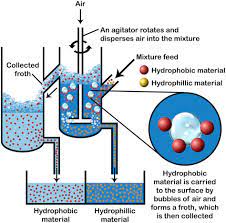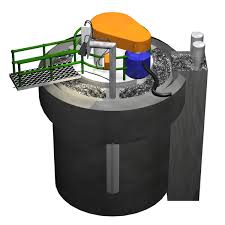Having dealt with sedimentation process to this extent in some of our previous articles, this article will be used to treat flotation process with the view to understanding same equally.
Meaning of Flotation Process
Flotation process (sometimes called flotation separation) is a method of separation widely used in the waste-water treatment and mineral processing industries.
It is an alternative to sedimentation that is used in the treatment of some waste-water in which air is forced into the waste- water under pressures of 1.75 to 3.5 kg per sq cm (25 to 50 1b per sq in).
Read Also: Types and Sources of Waste-Water
The waste-water, supersaturated with air, is then discharged into an open tank; there the rising air bubbles cause the suspended solids to rise to the surface, where they are removed. Flotation can remove more than 75 percent of the suspended solids.
Various Flotation Processes
The above discusses the processes or conditions under which flotation works efficiently. According to Wikipedia, Flotation process, the various flotation processes include the following:
- Dissolved air flotation.
- Induced gas flotation.
- Froth flotation; typical in the mineral processing industry.
1. Dissolved Air Flotation
A closer look at the above definition or its explanation shows that Dissolved Air Flotation (DAF) has been discussed. When particles to be removed do not settle out of solution easily, dissolved air flotation is often used.
It is used in water and waste- water treatment processes. In the water treatment, after coagulation and flocculation processes, water flows to DAF tanks where air diffusers on the tank bottom create fine bubbles that attach to floc resulting in a floating mass of concentrated floc.

The floating floc blanket is removed from the surface and clarified water is withdrawn from the bottom of the DAF tank ( Edzwald, 2011).
2. Induced Gas Flotation
This is done when other gases outside air (oxygen) is/are used to cause or effect flotation. It is found useful in water and waste-water treatment processes.
3. Froth Flotation
This is typical in the mineral processing industry. In the sewage treatment, in some larger plants, fat and grease are removed by passing the sewage through a small tank where skimmers collect the fat floating on the surface.
Air blowers in the base of the tank may also be used to help recover the fat as froth. Many plants, however, use primary clarifiers with mechanical surface skimmers for fat and grease removal. In the mineral processing industry, it is used mainly to recover or remove fats and oil from the other main constituent substances.
Flotation Process in Waste-water Treatment
Not much will again be said about this in this section as all vital information is already contained in our previous articles. Flotation process in waste-water treatment does help achieve the removal of oils, grease and some suspended solids through the methods explained above. Those parts removed therefore stand as the specific treatment objectives of flotation process.
Read Also: Impacts of Waste-water on the Environment, Treatment objectives and Disposal Regulations
From our discussion so far, one can conclude that sedimentation and flotation are processes found useful in the primary treatment of water or waste-water. Major focus in this unit has been that of the latter.
While sedimentation deals with the removal of suspended solids, flotation deals with the removal of oils, grease and some solids that might stick with the oils. Just as there are factors affecting sedimentation, there are equally different sizes and shapes of sedimentation tanks.

